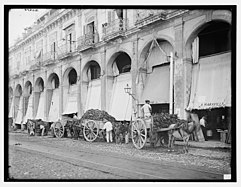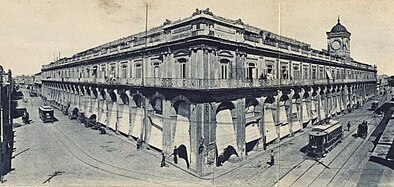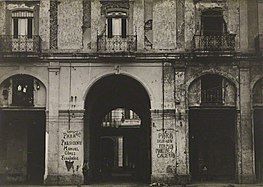Plaza del Vapor, Havana
| Plaza del Vapor, Havana | |
|---|---|
Mercado de Tacon | |
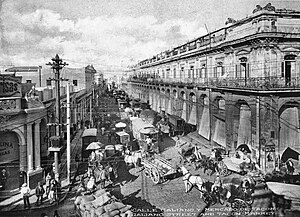 Plaza del Vapor, corner of Calles Galiano and Reina. | |
 | |
| Alternative names | Mercado Tacón |
| General information | |
| Type | Courtyard |
| Architectural style | Neoclassical |
| Location | Calles Galiano and Reina |
| Town or city | Havana |
| Country | Cuba |
| Coordinates | 23°07′59″N 82°21′45″W / 23.132975°N 82.362409°W |
| Estimated completion | 1835 |
| Renovated | 1874 |
| Demolished | 1959 |
| Owner | Revolutionary government without 5authority demolished the Plaza.[a][2][3] |
| Height | |
| Top floor | 9.65 metres (31.7 ft) |
| Technical details | |
| Structural system | Steel & masonry |
| Material | Masonry |
| Size | 84 metres (276 ft) x 123 metres (404 ft) |
| Floor count | 3 |
| Grounds | 10,345.1 square metres (111,354 sq ft) |
| Design and construction | |
| Architect(s) | Rayneri and Sorrentino |
| Developer | Francisco Martí |
| Known for | Central market |

The Plaza del Vapor was a covered market in Havana, it was completed in 1835. Its name derives from its builder Francisco Martí who became later the impresario of the Tacón Theatre and who had a monopoly of fish trade in the city. Martí had a painting placed against a wall from a bar of the ship El Neptuno, the first vapor (steam ship) that made regular round trips between Havana and Matanzas. "It was the image of that ship that ended up naming the building."[4] From the Plaza del Vapor, Martí sold 50% of all the lottery tickets.[5] in Cuba.[6]
History

In the early morning of September 7, 1872 a fire destroyed the previous mercado de Tacón and it was necessary to install a provisional market in the
Andrés Stanislas Romay writes about the Plaza del Vapor:
"Meanwhile the animation reigns in the inner enclosure of the square, that as by charm you see transformed into a kind of fair. If you do not want to be a philosopher, the diversity of physiognomy, costumes, conversations, will serve as a distraction, or you will contemplate with satisfaction the golden pineapple, the purple mangoes, the velvety caimito and other thousand rich fruits of the tropical fields. But behold, this agitation gradually subsides, the concurrence disappears and with it the square is almost deserted. Do you think that this building is then totally destitute of interest? No,: it is then transformed into a temple of love, of that subtle spirit that penetrates whenever man puts his mark and who does not disdain to visit the darkest shelter at the same time as the most majestic palace?[8]
Chinatown

El Barrio Chino was Havana's Chinatown, located in the area of the Plaza de Vapor. It was once Latin America's largest Chinese community,
The first 206 Chinese-born arrived in Havana on June 3, 1847.[14] The neighborhood was booming with Chinese restaurants, laundries, banks, pharmacies, theaters and several Chinese-language newspapers, the neighborhood comprised 44 square blocks during its prime.[9][13] The heart of the Barrio Chino was the Plaza del Vapor on el Cuchillo de Zanja (Zanja Canal). The strip was a pedestrian-only street adorned with lanterns, red paper dragons and other Chinese cultural items; there were a great number of authentic Cuban-Chinese restaurants.
Some 5,000 immigrants from the U.S. came to Cuba during the late 19th century to escape the discrimination present at the time. Another, albeit smaller wave of Chinese immigrants, also arrived during the 20th century, some as supporters of the communist cause during the Cuban revolution and others as dissidents escaping the authorities in China.
There were almost no women among the nearly entirely male Chinese coolie population that migrated to Cuba(1%).[15][16] In Cuba some Indian (Native American), mulatto, black and white women engaged in carnal relations or marriages with Chinese men, with marriages of mulatto, black and white women being reported by the Cuba Commission Report.[17]
120,000 Cantonese 'coolies' (all males) entered Cuba under contract for 8 years. Most of these men did not marry, but Hung Hui (1975:80) cites there was a frequency of sexual activity between black women and these Asian immigrants. According to Osberg (1965:69) the free Chinese practice of buying slave women and then freeing them expressly for marriage was utilized at length. In the nineteenth and twentieth centuries, Chinese men (Cantonese) engaged in sexual activity with black Cuban women, and from such relations many children were born.[18]
In the 1920s, an additional 30,000 Cantonese and small groups of Japanese also arrived; both immigrations were exclusively male and there was rapid intermarriage with white, black and mulato populations.[19] CIA World Factbook. Cuba. 2008. May 15, 2008. claimed 114,240 Chinese-Cuban coolies with only 300 pure Chinese.[20]
In the study of genetic origin, admixture and asymmetry in maternal and paternal human lineages in Cuba, thirty-five Y-chromosome SNPs were typed in the 132 male individuals of the Cuban sample. The study does not include any people with some Chinese ancestry. All the samples were white Cubans and black Cubans. Two out of 132 male samples belong to East Asian Haplogroup O2 which is found in significant frequencies among Cantonese people is found in 1.5% of Cuban population.[21] In the 1920s, an additional 30,000 Chinese arrived; the immigrants were exclusively male. In 1980, 4000 Chinese lived there, but by 2002, only 300 pure Chinese were left.[22]

Two thousand Chinese, consisting of Cantonese and Hakkas, fought with the rebels in Cuba's Ten Years' War, and a monument in Havana honours the Cuban Chinese who fell in the war on which is inscribed: "There was not one Cuban Chinese deserter, not one Cuban Chinese traitor."[23] Chinese Cubans, including some Chinese-Americans from California, joined the Spanish–American War in 1898 to achieve independence from Spain, but a few Chinese, who were loyal to Spain, left Cuba and went to Spain. Racial acceptance and assimilation would come later.
The district has two
The Chinese Cubans fought in the Cuban war of independence on the side of those seeking independence from Spain. A memorial consisting of a broken column memorializes Chinese participation in the war of independence at the corners of L and Linea in Havana. While many fled, some Chinese stayed after the start of Fidel Castro's rule in 1961. Younger generations are working in a wider variety of jobs than the previous generation. Many are entering show-business as song composers, actors, actresses, singers, and models.
Shanghai Theatre
Was a few blocks from the Plaza del Vapor, on Calle Zanja at # 205 (W-9497).[c][2] "Located in Chinatown, the old, hot and uncomfortable Shanghai Theater [28] has the only public burlesque in Havana. Girls strip completely (no G-strings). This theater is probably one of the few places in the world which openly shows pornographic movies. Admission is $1.25, but varies according to the location of the seats..." [29]
Vapor

A weekly service between Havana and Matanzas by the steamship the "Neptune" began its service on July 18, 1819, leaving Havana on Wednesdays at six in the morning for Matanzas and returning on Sundays at the same time, and carrying correspondence, cargo and passengers. The Plaza de Tacón, which was subsequently known as “del Vapor”, received this last name because “Pancho” Martí, owner of the first existing restaurants located in the corner of Galiano and Dragones, placed a painting on the wall that represented the steamship “Neptune”, baptizing and connecting forever the Plaza with the name "vapor," (steam).[30]
Architecture

The building site is roughly square in shape, the building had a playground-courtyard in the middle[31] and an 8.3 metres (27 ft) high Colonnade surrounded by shops along the perimeter facing Calles Galiano, Reina, Aguila, and Dragones. The ground floor was commercial, the upper floors were occupied by the residences of some 200 families.[6] In 1840 the building was remodeled into its characteristic colossal mass of masonry arches comprising the height of the ground and second floor. On the front of Reina Street, the architect, Eugenio Rayneri Sorrentino, designed a central, square, domed turret with a four dial clock, the entrance to the courtyard.
Concrete slab

In this building, Rayneri used steel beams in the ceilings spaced 70 cm apart supporting mud slabs, which were then a novelty in Havana. Unreinforced or "plain"[32] slabs are today rare and have limited practical applications, with one exception being the mud slab. They were once common, but the economic value of reinforced ground-bearing slabs has become more appealing for many engineers.[33] Without reinforcement, the entire load on these slabs is supported by the strength of the concrete, which becomes a vital factor. As a result, any stress induced by a load, static or dynamic, must be within the limit of the concrete's flexural strength to prevent cracking.[34] Since unreinforced concrete is relatively very weak in tension, it is important to consider the effects of tensile stress caused by reactive soil, wind uplift, thermal expansion, and cracking.[35] One of the most common applications for unreinforced slabs is in concrete roads. Mud slabs, also known as rat slabs, are thinner than the more common suspended or ground-bearing slabs (usually 50 to 150 mm), and usually contain no reinforcement.[36] This makes them economical and easy to install for temporary or low-usage purposes such as subfloors, crawlspaces, pathways, paving, and levelling surfaces.[37] In general, they may be used for any application which requires a flat, clean surface. This includes use as a base or "sub-slab" for a larger structural slab. On uneven or steep surfaces, this preparatory measure is necessary to provide a flat surface on which to install rebar and waterproofing membranes.[33] In this application, a mud slab also prevents the plastic bar chairs from sinking into soft topsoil which can cause spalling due to incomplete coverage of the steel. Sometimes a mud slab may be a substitute for coarse aggregate. Mud slabs typically have a moderately rough surface, finished with a float.[33]
Wrought iron

The main facade facing Calle Reina had a clock tower in the center of the building. Wrought iron frames at the playground and decorative railings throughout the building had the letters MT, the initials of Miguel Tacon. The railings of the balconies were later reused around the fontains in the renovation of Parque Central. The architects were notable for their design of wrought iron railings in the balconies, in the mezzanine and in the upper floor.[38] Before the development of effective methods of steelmaking and the availability of large quantities of steel, wrought iron was the most common form of malleable iron. It was given the name wrought because it was hammered, rolled or otherwise worked while hot enough to expel molten slag. The modern functional equivalent of wrought iron is mild steel, also called low-carbon steel. Neither wrought iron nor mild steel contain enough carbon to be hardenable by heating and quenching.[39]: 145
Wrought iron is highly refined, with a small amount of slag forged out into fibres. It consists of around 99.4% iron by mass.[40] The presence of slag is beneficial for blacksmithing operations, and gives the material its unique fibrous structure.[41] The silicate filaments of the slag also protect the iron from corrosion and diminish the effect of fatigue caused by shock and vibration.[42]
Historically, a modest amount of wrought iron was refined into
Many items, before they came to be made of
Wrought iron is no longer produced on a commercial scale. Many products described as wrought iron, such as guard rails, garden furniture[44] and gates, are actually made of mild steel.[45] They retain that description because they are made to resemble objects which in the past were wrought (worked) by hand by a blacksmith (although many decorative iron objects, including fences and gates, were often cast rather than wrought).[45]
Vendors

Sergio R. San Pedro del Valle says in his book Lived Yesterday (Miami, 2008), that there were more than 160 shops that opened their doors in the Plaza del Vapor. There were more than 160 businesses in the Plaza del vapor.[4] Carlos Rodríguez Búa writing about the nearby "El Barrio Chino" notes: "...the Plaza del Vapor occupied la manzana (the entire block) between Galiano,[7] Reina, Dragones and Águila streets and about 1824 there were established without any order and with the most petty irregularity the vendors of daily supplies for that part new of the population, so that the best of those positions were uneven wooden blocks that belonged to different owners.
I knew the Plaza del Vapor already in its decline, at the end of the 50s and it was incredible the amount of small businesses that were piled up there. I'll talk about it again because it was located in the neighborhood of Chinatown and there were a few of them there. I used to go there every week to buy the discs with 45 revolutions per minute that on the site were obtained at a third of the official price in nightclubs (thirty-five cents against a peso and ten cents that normally cost), as well as to the bookstores of use in which you took me masterpieces for a few cents, as well as the expensive National Geographic magazines already used."[46]
Lottery
The main, upper floor was all residential and occupied by the homes of some 200 families. The building was mostly a market for the national lottery,[47] and sold no less than 50 percent of the tickets that were printed for the entire country.[48] In 1947, the Ministry of Health closed the Mercado de Colón or Plaza del Polvorín, and the vendors operating in it relocated to the central courtyard of the Plaza del Vapor, putting an end to the baseball and football games that took place in this space.
Viyaya

Nicolás Tanco Armero writes about Viyaya a baseball player at the Plaza del Vapor; he notes that Viyaya played in baseball games that were organized in the central courtyard,[31] they had named the team El Deportivo Tacón, a team from the neighborhood, and enjoyed enormous popularity because a female tenant from the Plaza del Vapor was part of the team: she was named Eulalia González but everyone knew as Viyaya.[4] A girl playing baseball in Havana, and not only in the Plaza del Vapor, but in the most renowned pleasures of the Havana and even in certain localities of the interior all during the decades of the 40s and 50s. Viyaya played several positions, even was a lefty pitcher, but where she became famous was at first base. She was something to watch. Elio Menéndez, who won the national journalism award says about her: "She excelled more on defense than at bat, although she was not an out and out player. The rival pitchers had no regard for her. No pitcher saw well that a woman could hit against him and to avoid it the ball was thrown close to her body which gave rise to many verbal fights." In April 1947 the American businessman Max Carey came to Cuba with two baseball groups made up of women, and hired Viyaya to play in the USA. She went and returned shortly, to continue playing on the grounds of the Plaza del Vapor.[4]
El Curita

The Little Priest, after whom the Parque El Curita is named, was born in
Demolition
The Plaza del Vapor met a similar fate in 1959 as the
At the beginning of the 1959 Revolution Fidel Castro ordered to stop all construction in Cuba, and to have the Plaza del Vapor demolished; the Ministry of Public Health declared the Plaza del Vapor unhealthy and its vendors were resettled on the grounds of Calle Amistad between Calles Estrella and Monte where the demolished Mars and Belona dance academy had operated for years. The National Institute of Savings and Housing (INAV)[e] replaced Batista's National Lottery, which had been abolished by the Revolutionary government, and a new lottery to raise money for new construction, and directed by Pastorita Núñez who projected that a new, modern building, not unlike those that were proposed by Josep Lluís Sert a year earlier in his Havana Plan Piloto of 1955-1958 would now be built in the empty lot.[51]
Núñez proposal

The project for a new, modern, high-rise slab building to replace the Plaza del Vapor was designed by the architect Carlos Alfonso. It consisted of a basement for parking 350 cars, a commercial ground floor, a second-floor reserved for the additional parking of 250 cars, and on top, a public, recreational area; there were 20 levels of 10 apartments each. Shortly after the work began, Pastorita Núñez' National Institute of Savings and Housing, and the National Planning Board abandoned the project, and instead proposed a park that was baptized with the name Parque del Curita; the park exists in that location to this day.[52][53][f] Although some newspapers of the time wrote at the end of 1959 that the work for the construction of the new building had begun, Carlos Alfonso's building was never built.[51] The wholesale market unlike Les Halles in Paris was not relocated and little effort was made for its continuance.
Parti pris
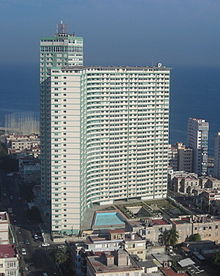

The
Gallery
-
Vendors along Calle Galiano.
-
Plaza del Vapor showing the Calle Galiano at the corner of Calle Reina, 1900.
-
Corner Calle Galiano and Reina, with added structure on roof
-
exit from square to calle Reina (1933)
See also
- Chinese Cubans
- Campo de Marte, Havana
- Palacio de Aldama
- Palacio de la Marquesa de Villalba
- Tacón Theatre
- Les Halles
- El Capitolio
- List of buildings in Havana
Notes
- ^ This theft of private property led the U.S. into severing diplomatic relations in 1961 and installing the trade embargo and various sanctions against Cuba. "Thousands of Americans and Cuban citizens suffered humiliation and financial distresses of having their private property stolen from them, some of them at gunpoint. Today there has been no justice for their claims."[1]
- ^ A Paifang, also known as a pailou, is a traditional style of Chinese architectural arch or gateway structure. Evolved from Indian-subcontinent's Torana through the introduction of Buddhism to China, it has developed many styles and has been introduced to other East Asian countries such as Korea, Japan, and Vietnam.
- ^ "A good Havana burlesque will stay out of the red as easily as a bad one, and we feel that nothing is too good for our customers. When they come expecting to see an artistic performance, we will give it to them."[27]
- ^ Some but not all of these items are mentioned in Gordon, R. B. (1996)[43]
- ^ a state agency created with the objective of building houses for all Cubans who lacked them a lottery,[51]
- ^ it has been said the real objective of razing the Plaza del Vapor was an attempt to erase the republican history of the area.[51]
- ^ "A primary protagonist was Rudolf Wittkower, who had published important essays on role of geometry in the works of Alberti and Palladio, essays later collected in Architectural Principles in the Age of Humanism (1949, 1962). The book includes Palladio's Geometry: the Villas, in which Wittkower argues that a similar organizational schema underlies all the villas of Palladio. Wittkower's diagrams of the villas are variations of a three-bay by a three-bay diagram; a nine-square grid. Wittkower suggests that Palladio's villas can be considered as a single conceptual project based on variations of an ideal plan diagram: “What was in Palladio's mind when he experimented over and over again with the same elements? Once he had found the basic geometric pattern for the problem ‘villa,’ he adapted it as clearly and as simply as possible to the special requirements of each commission. He reconciled the truth at hand with the ‘certain truth’ of mathematics which is final and unchangeable.”
- Parti pris[55] is an organizing thought or decision behind an architect's design, presented in the form of a basic diagram or a simple statement.[56]It may be shortened to "parti". The term comes from 15th century French, in which "parti pris" meant "decision taken." Later, it took on the meaning of "bias" or "prejudice".[57]
References
- ^ "HEARING BEFORE THE SUBCOMMITTEE ON THE WESTERN HEMISPHERE of the COMMITTEE ON FOREIGN AFFAIRS HOUSE OF REPRESENTATIVES ONE HUNDRED FOURTEENTH CONGRESS FIRST SESSION". Retrieved 2020-02-25.
- ^ "Trump Administration Authorizes Lawsuits Against Companies That Deal in Property Confiscated by the Cuban Government and Tightens Other Sanctions Against Cuba". Retrieved 2022-05-12.
- ^ "US Allows Lawsuits Relating to "Trafficking" in Confiscated Property in Cuba". Retrieved 2022-05-12.
- ^ a b c d e f "LA PLAZA DEL VAPOR". 11 May 2015. Retrieved 2018-12-22.
- ^ "Photo" (JPG). www.cubacollectibles.com. Retrieved 2021-04-02.
- ^ a b c "MEMORIES: Plaza del Vapor Recuerdos de la Habana, Plaza del Vapor". Retrieved 2018-12-21.
- ^ a b "Photo" (JPG). i.pinimg.com. Retrieved 2021-04-02.
- ^ a b "HOTEL TELÉGRAFO. La Plaza del Vapor, Revista de la Habana, 1854, Volúmenes 2-3, pp. 28-31". 15 September 2013. Retrieved 2018-12-21.
- ^ a b Havana's Chinatown Archived September 27, 2007, at the Wayback Machine – The once largest Chinese community in Latin America
- ^ a b China Today Chinese in Cuba
- ^ Embassy of Cuba in Beijing, History of Chinese in Cuba[permanent dead link] Surgido en la segunda mitad del siglo XIX, el Barrio Chino de La Habana experimentó un rápido desarrollo y llegó a convertirse, en la siguiente centuria, en el más importante de América Latina.
- ^ Rafael Lam "Chinese from Manila in Cuba"
- ^ a b Embassy of Cuba in Beijing-Immigration in Cuba Archived February 3, 2009, at the Wayback Machine
- ^ Cuba Culture "Aportes de los chinos en Cuba"
- ISBN 978-9004182134. Retrieved May 17, 2014.
- ISBN 0226560252. Retrieved May 17, 2014.
- ISBN 978-1469612966. Retrieved May 17, 2014.
- ^ "Sino-Cubans: Race, gender and sexuality as discourse" (PDF). Retrieved December 31, 2011: (For a British Caribbean model of Chinese cultural retention through procreation with black women, see Patterson, 322-31).
{{cite web}}: CS1 maint: postscript (link)[dead link] - ISBN 9780864424037.
- ^ "The World Factbook". cia.gov. 16 November 2021.
- PMID 18644108.
- ^ http://www.uv.es/EBRIT/macro/macro_5006_64_24.html [permanent dead link]
- ISBN 978-0465019335
- ISBN 978-81-206-0160-4.
- ^ Wikipedia contributors, "Chinatown," Wikipedia, The Free Encyclopedia, https://en.wikipedia.org/w/index.php?title=Chinatown&oldid=936743236 (accessed January 23, 2020).
- ^ El Barrio Chino de la Habana – Havana's Barrio Chino (in Spanish)
- ^ "SHANGHAI THEATER WORLD'S RAWEST BURLESQUE SHOW HAVANA CUBA 1956". Retrieved 2022-02-17.
- ^ "Havana's Chinatown and the Shanghai Theater". Oncubanews. July 2019. Retrieved 29 May 2022.
- ^ "GUIDE TO AFTER-DARK HAVANA 1956, Cabaret Yearbook, Winter Resort Number, Volume One, poss 1956, p68". Retrieved 2020-02-17.
- ^ "LOS BUQUES DE VAPOR EN CUBA. by D. Jácome)". Facebook. Retrieved 2020-01-19.
- ^ a b "View of Havana [Plaza del Vapor, Market Area, Havana] (Getty Museum)". The J. Paul Getty in Los Angeles.
- ^ Garrison, Tim (19 February 2014). "Clearing the confusion on 'plain concrete'". Civil & Structural Engineer. Archived from the original on 8 May 2019. Retrieved 8 May 2019.
- ^ ISBN 978-0-7506-6656-5.
- ^ Walker, Wayne. "Reinforcement for slabs on ground". Concrete Construction. Retrieved 8 May 2019.
- ^ "Rupture depth of an unreinforced concrete slab on grade" (PDF). Aluminium Association of Florida, Inc.
- ^ Arcoma, Peter. "What is a mud slab?". Builder-Questions.com. Retrieved 8 May 2019.
- ^ Postma, Mark; et al. "Floor Slabs". Whole Building Design Guide. National Institute of Building Sciences. Retrieved 8 May 2019.
- ^ de las Cuevas Toraya, J. 500 años de construcciones en Cuba. Santos, G.S. Valdés, A.P. 9788460731597. [1]. 2001. Chavín, Servicios Gráficos y Editoriales
- ISBN 978-0901462886.
- ^ "Wrought Iron – Properties, Applications". A to Z of Materials. AZoNetwork. 13 August 2013. Retrieved 27 October 2019.
- ^ Alex Walter (31 October 2018). "What is wrought iron?". Mechanical Site. Retrieved 27 October 2019.
- ^ "What is wrought iron?". Iron Gates N Railings Ltd. 2017. Retrieved 27 October 2019.
- ^ ISBN 0-8018-6816-5.
- ^ "Wrought Iron: A Patio Furniture dream". cnet reviews. Retrieved 29 September 2009.
- ^ a b Daniel, Todd. "Clearing the Confusion Over Wrought Iron". Fabricator. No. November/December 1993. NOMMA. p. 38.
- ^ "BARRIO CHINO". 5 May 2014. Retrieved 2018-12-21.
- ^ "Cuba Lottery Tickets". The Cuban History. Retrieved 29 May 2022.
- ^ "Men at local lottery shops". The History, Culture and Legacy of the People of Cuba. Retrieved 29 May 2022.
- ^ Wikipedia contributors. (2019, December 28). Les Halles. In Wikipedia, The Free Encyclopedia. Retrieved 16:09, January 18, 2020, from https://en.wikipedia.org/w/index.php?title=Les_Halles&oldid=932764812
- ^ Parimage, "Les Halles, The New Heart of Paris". Mairie de Paris and SemPariSeine, July 2012.
- ^ a b c d "Los proyectos inconclusos o fracasados de Fidel Castro". Retrieved 2020-01-18.
- ^ "Los proyectos inconclusos o fracasados de Fidel Castro". 5 December 2017. Retrieved 2020-01-19.
- ^ Hernández, Ruslan Muñoz; Loureda, María Victoria Zardoya. "Las "casas de Pastorita" en La Habana"". Arquitectura y Urbanismo. XXXVII (1): 37–50. Retrieved 2020-01-19.
- ^ "Lever House, New York City | 115090". Emporis. 1952-04-29. Archived from the original on February 20, 2015. Retrieved 2022-05-03.
- ^ James Stevens Curl (2000). parti. Oxford University Press. Retrieved May 17, 2009.
{{cite book}}:|work=ignored (help) - ISBN 0-442-02462-2.
- ^ One, Blue (21 November 2012). "An Introduction to Architecture and Visual Communications: parti". Arch100and110.blogspot.com. Retrieved 18 October 2018.
External links
- EN ESTO SE HA CONVERTIDO LA CALLE ZANJA
- Calle Reina
- Parque El Curita
- Walker Evans, Plaza del Vapor
- Walber Evans
- Walker Evans_Interior of Plaza del Vapor
- Digital Photographic Archive of Historic Havana
Plaza del Vapor, Havana Q60764334

